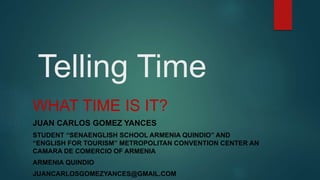Telling Time
- 1. Telling Time WHAT TIME IS IT? JUAN CARLOS GOMEZ YANCES STUDENT “SENAENGLISH SCHOOL ARMENIA QUINDIO” AND “ENGLISH FOR TOURISM” METROPOLITAN CONVENTION CENTER AN CAMARA DE COMERCIO OF ARMENIA ARMENIA QUINDIO JUANCARLOSGOMEZYANCES@GMAIL.COM
- 2. Whatch or Clocks  Whatches Clocks
- 3. What Thime is it?
- 4. TIME (1) When it's "on the hour" we say "o'clock". But only when it's on the hour.
- 6. TIME (2)  In five minute increments, when it's past the hour (up to 30 minutes past) we say "past".  When it's before the hour (after 30 minutes past) we say "to".  There are 60 minutes in an hour.  30 minutes is half an hour, we say "half past" or "thirty".  15 minutes is quarter of an hour, we say "quarter past" or "fifteen" or "quarter to" or "forty-five".
- 17. The way people write the time varies. I prefer a.m. and p.m. Choose from the following styles or use what your English teacher tells you to and stick to it:- a.m. p.m. am pm AM PM A.M. P.M. Some people (myself included) use a dot as the separator: 2.30 pm. Some people use a colon as the separator: 2:30 pm. The colon is usually used with the 24-hour clock: 14:30. When you are writing the time decide whether to write it using numerals or words, and stick to that.
- 19. THANK YOU



















